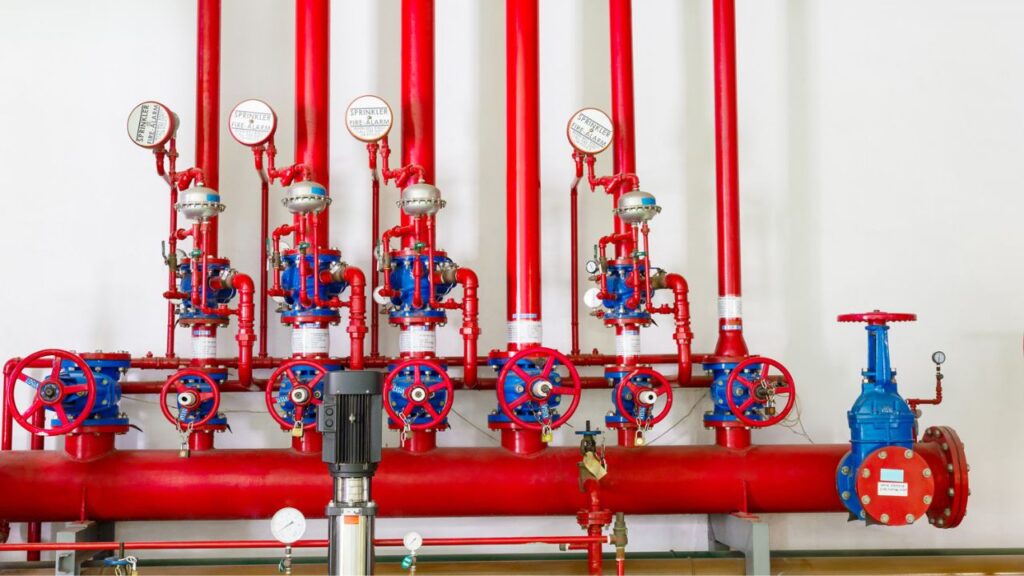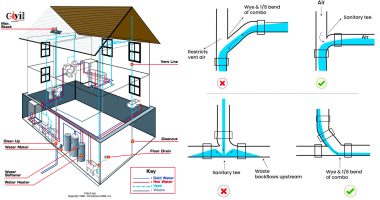Just how do you feel with regards to The Inner Workings of Your Home's Plumbing?

Recognizing how your home's plumbing system works is vital for each house owner. From supplying tidy water for alcohol consumption, food preparation, and showering to safely getting rid of wastewater, a properly maintained pipes system is critical for your family members's health and wellness and convenience. In this thorough overview, we'll discover the detailed network that comprises your home's pipes and deal ideas on maintenance, upgrades, and dealing with common issues.
Intro
Your home's pipes system is greater than simply a network of pipelines; it's an intricate system that guarantees you have accessibility to tidy water and effective wastewater removal. Understanding its components and how they collaborate can assist you stop pricey repairs and ensure everything runs efficiently.
Standard Parts of a Plumbing System
Pipes and Tubing
At the heart of your plumbing system are the pipelines and tubes that bring water throughout your home. These can be made of various products such as copper, PVC, or PEX, each with its advantages in terms of sturdiness and cost-effectiveness.
Fixtures: Sinks, Toilets, Showers, etc.
Fixtures like sinks, bathrooms, showers, and tubs are where water is utilized in your house. Comprehending just how these components link to the pipes system aids in detecting troubles and intending upgrades.
Shutoffs and Shut-off Points
Valves manage the flow of water in your pipes system. Shut-off shutoffs are vital during emergencies or when you need to make repairs, allowing you to isolate parts of the system without disrupting water circulation to the whole residence.
Water System System
Main Water Line
The main water line connects your home to the municipal water supply or an exclusive well. It's where water enters your home and is dispersed to different fixtures.
Water Meter and Pressure Regulator
The water meter measures your water use, while a stress regulator ensures that water flows at a secure stress throughout your home's plumbing system, avoiding damage to pipelines and components.
Cold Water vs. Hot Water Lines
Recognizing the distinction in between cold water lines, which provide water directly from the primary, and hot water lines, which lug heated water from the hot water heater, helps in troubleshooting and preparing for upgrades.
Drain System
Drain Pipes Pipeline and Traps
Drain pipelines lug wastewater away from sinks, showers, and toilets to the sewage system or septic system. Traps prevent sewage system gases from entering your home and likewise trap particles that might cause obstructions.
Ventilation Pipelines
Air flow pipes permit air into the drainage system, stopping suction that might reduce drain and cause catches to empty. Correct air flow is important for keeping the stability of your pipes system.
Value of Correct Drain
Ensuring appropriate drainage stops backups and water damages. Frequently cleansing drains and keeping traps can protect against expensive repairs and prolong the life of your pipes system.
Water Heating Unit
Sorts Of Water Heaters
Hot water heater can be tankless or conventional tank-style. Tankless heating systems warmth water on demand, while containers store heated water for prompt use.
Just How Water Heaters Connect to the Pipes System
Recognizing exactly how hot water heater attach to both the cold water supply and hot water circulation lines helps in identifying concerns like insufficient hot water or leaks.
Maintenance Tips for Water Heaters
On a regular basis purging your hot water heater to get rid of debris, checking the temperature setups, and examining for leakages can expand its lifespan and enhance power efficiency.
Common Pipes Concerns
Leaks and Their Causes
Leakages can take place as a result of aging pipes, loosened installations, or high water pressure. Dealing with leakages without delay prevents water damage and mold development.
Obstructions and Blockages
Blockages in drains pipes and commodes are often caused by flushing non-flushable products or a build-up of oil and hair. Making use of drainpipe displays and being mindful of what goes down your drains can stop obstructions.
Indicators of Pipes Problems to Watch For
Low water pressure, sluggish drains, foul odors, or abnormally high water expenses are indications of possible pipes problems that ought to be attended to without delay.
Pipes Upkeep Tips
Normal Examinations and Checks
Schedule annual plumbing inspections to catch issues early. Try to find indications of leakages, deterioration, or mineral accumulation in taps and showerheads.
Do It Yourself Upkeep Tasks
Basic jobs like cleansing tap aerators, looking for bathroom leakages using dye tablets, or insulating revealed pipelines in cool climates can prevent major plumbing problems.
When to Call a Specialist Plumber
Know when a plumbing problem needs expert competence. Attempting complicated repair services without proper expertise can lead to more damage and higher repair costs.
Upgrading Your Plumbing System
Reasons for Upgrading
Updating to water-efficient components or changing old pipelines can boost water top quality, minimize water costs, and boost the worth of your home.
Modern Pipes Technologies and Their Benefits
Explore technologies like smart leak detectors, water-saving toilets, and energy-efficient water heaters that can conserve cash and lower ecological influence.
Expense Factors To Consider and ROI
Determine the in advance expenses versus long-term savings when taking into consideration pipes upgrades. Lots of upgrades pay for themselves with decreased utility bills and less fixings.
Ecological Effect and Conservation
Water-Saving Fixtures and Devices
Mounting low-flow faucets, showerheads, and toilets can significantly reduce water use without compromising performance.
Tips for Reducing Water Use
Basic practices like dealing with leakages promptly, taking shorter showers, and running complete loads of washing and recipes can save water and lower your energy expenses.
Eco-Friendly Plumbing Options
Consider lasting plumbing products like bamboo for flooring, which is durable and eco-friendly, or recycled glass for kitchen counters.
Emergency Readiness
Steps to Take Throughout a Pipes Emergency
Know where your shut-off shutoffs lie and exactly how to turn off the water in case of a ruptured pipe or significant leak.
Relevance of Having Emergency Contacts Helpful
Keep call info for local plumbing professionals or emergency solutions conveniently available for fast reaction throughout a plumbing dilemma.
DIY Emergency Situation Fixes (When Appropriate).
Short-lived fixes like making use of duct tape to spot a leaking pipeline or positioning a bucket under a leaking tap can minimize damage up until a specialist plumber arrives.
Conclusion.
Comprehending the makeup of your home's plumbing system encourages you to maintain it efficiently, conserving time and money on repair services. By following routine upkeep routines and remaining educated about contemporary pipes technologies, you can guarantee your pipes system operates effectively for several years ahead.
HOW YOUR PLUMBING SYSTEM WORKS
Which Pipes Do What?
- Blue lines = fresh water supply entering the building
- Red lines = hot water supply entering the building
- Grey lines = pipes carrying waste away from the building and venting pipes carrying gases away from the building (through the roof)
YOUR MAIN PLUMBING SYSTEMS
There are two main plumbing systems that support your home s basic plumbing needs one that brings clean water into your home, and one that sends dirty water away from your home. Connected to the toilet, bath, shower, and other faucets in your home, these two systems keep your water flowing in the right directions.
ACCESSING FRESH WATER
Fresh and clean water is brought into your home through the main water supply line . Filtered through one pipe, this water is pressured to flow into the various fixtures in your home at any given time.
This water can be sourced from a well located on your property, a pond or river (mostly cottages), or, as in most cases, from the city s municipal water treatment centre. However, it is important to note that water that is untreated, such as the water siphoned from ponds or rivers, may not be safe to drink. Personal water supplies always need to be treated for hardness and contaminants before consumed.
MUNICIPAL WATER SUPPLIES
- Improve taste and odour
- Remove sediment
- Eliminate hardness
- Reduce chlorine
COLD WATER SUPPLY VS. HOT WATER SUPPLY
Cold water flows into your home or building through the service line, which then distributes hot or cold water to your fixtures. This line is most commonly run through a central column that runs floor to floor. Hot water runs in short and straight pipes as the longer the pipeline, the more heat that will be lost in the transfer. Having shorter pipes also allows residents to access hot water more quickly.
WASTE WATER SYSTEM
Your wastewater system is divided into two parts pipes that send wastewater away from your home and venting pipes that send sewer gas away from your home. Sewage water travels through pipes that flush the water and waste towards local sewers that are operated and managed by your city or town. Most sewer systems rely on gravity to move the wastewater to where it needs to go.
The further away from your toilet or sink, the larger wastewater pipes become. This allows for waste to be disposed of from various parts of your home or business at once without pipe blockages. The angle and flow of these pipes are also essential for keeping your waste pipes clear of build up.
https://harrisplumbing.ca/how-your-home-plumbing-system-works/

As a devoted reader about , I imagined sharing that information was beneficial. Sharing is caring. You won't know, you could be helping someone out. I treasure your readership.
Request A Quote
Comments on “An In-Depth Look at Your Property's Plumbing System Anatomy”